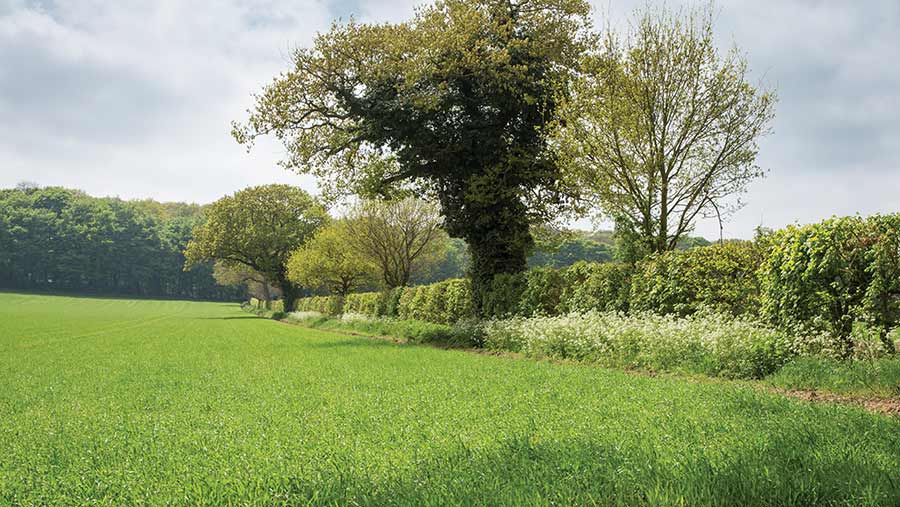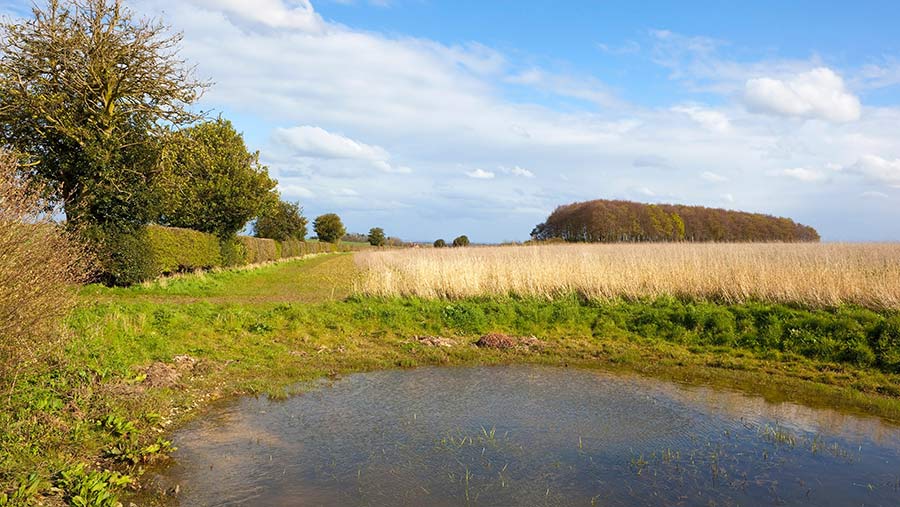How a coastal group’s audit is focusing biodiversity effort
 © GNP
© GNP The North Norfolk Coastal Group came together with the aim of collaborating to bring nature back to the farmed environment.
The group represents more than 55,000ha of coastal habitat – with the farmland included in that total area. It is home to 14,906 species of birds, plants and invertebrates
Thirty-six farmers and landowners are also part of a two-year Landscape Recovery pilot project, which is planning land use change to create continuous habitat managed for nature.
See also: Video: Grower completes world’s first Capulet bean harvest
One of the group’s first actions was to commission a biodiversity audit to confirm the species present on the land and identify the best actions to introduce to support them.
The audit was carried out by the University of East Anglia and provides the framework for habitat prioritisation.
It helps to inform decisions at all levels – from individual farm sites to the restoration and creation of large habitat blocks, needed for landscape recovery.
As Prof Paul Dolman explains, the work began with an audit of the North Norfolk coastal plain, which highlighted the importance of salt marsh for biodiversity, flood protection and carbon sequestration, as well as the role played by freshwater grazing marshes.
“The next stage of the audit involved the area’s farmland, which has 2,093 priority species among the total of almost 15,000,” he reports.
That work has helped to determine the key actions for increasing farmland biodiversity.
Which actions make the most difference?

© Emjay Smith/Adobe Stock
1. Annually cultivated non-rotational margins
These give the most bang for your buck, says Prof Paul Dolman.
They support 50% more of the priority species and four times as many of the rarest plants and invertebrates, when compared with grass margins, and can be found in Mid Tier Countryside Stewardship as option AB11, worth £552/ha.
The annual cultivation is essential, or they will grass over, he warns. “Establish them, let them regenerate and don’t move them – it takes time for rare species to accumulate.”
2. Hedges and scrub
Another key resource, supporting 51% of tree-associated species, especially where mature trees are found in the hedges.
Farmland is important for biodiversity, but semi-natural sites are crucial, he reveals, as three-quarters of rare species aren’t found in farmland.
Known as ‘the missing 73%’, their numbers will be boosted by farmers working together to create large blocks of habitat.
Large trees in hedgerows, especially dead ones, also have a role. “They are needed by these invertebrate species.”
3. Ponds
Restoring degraded ponds or digging new ones is also a key action, reports Carl Sayer of UCL, as they support 80 priority species.
“Ponds are the most neglected habitat, but they become species rich in a very short time if they are restored,” he says.
“This rapid recovery is because they act as insect chimneys and due to the fact that wetland biodiversity is very mobile.”
There are 23,000 ponds in Norfolk, he adds, many of which are overgrown, so their restoration will accelerate landscape-scale recovery.
The Numbers
1. Annually cultivated non-rotational margins v grass margins |
||||
| All priority species | Highest priority species | |||
| Plants | Invertebrates | Plants | Invertebrates | |
| Cultivated margins | 34 | 63 | 28 | 17 |
| High-quality grassland features | 12 | 55 | 8 | 5 |
2. Hedges and scrub |
||
| All priority species | ||
| Plants | Invertebrates | |
| Ancient woodland | 8 | 127 |
| Mature woodland | 6 | 126 |
| Young woodland | 2 | 97 |
| Natural scrub | 11 | 68 |
| Good hedges | 3 | 55 |
| Poor hedges | 3 | 24 |
3. Ponds |
||
| Pond Condition | All priority plants | Highest priority plants |
| Long established (good) | 17 | 7 |
| Long established (degraded) | 2 | 1 |
| Restored (from degraded) | 16 | 5 |
| Restored (from ghost) | 16 | 6 |
| New | 9 | 1 |
Getting the most from cultivated non-rotational margins
Having emerged as the top action for farmers in Norfolk to carry out, the use of annually cultivated margins (AB11) helps to support both rare arable weeds and priority invertebrates – contributing far more than grass margins.
Emily Swan of Natural England says that the easiest way to introduce them is to carry out the cultivations in either autumn or spring, in line with when the seed-bed is being prepared and with an awareness of the species present on the farm.
“They won’t deliver if you cultivate too late,” she warns. “So either October to November or February to mid April are best. Then you leave them to regenerate naturally.”
Going too early on the light land typical of the area can result in a sterile brome flush, she warns. “In the first year, it’s not uncommon to get a flush of nitrogen-tolerant weeds. Cultivating annually helps to prevent them from just grassing over, which has far less value for nature.
“If wild oats are present, you can run through the margins and knock the top off them – otherwise flip your cultivation timing the following year, from October to March, for example.”
That also works well with species such as creeping thistle, she adds.
Very shallow cultivations will favour grassweeds, so knowing what is likely to appear is helpful, she acknowledges. “But as the nutrient levels drop in these margins, the number of injurious weeds reduces.”
These non-rotational margins have been very successful at encouraging specific sparse plants, she notes.
Sown mix margins
Sown mixes, such as pollinator or wildflower strips, benefit many species, but are less floristically diverse than naturally regenerated margins, advises Prof Paul Dolman.
As a result, they provide fewer distinct micro-habitats and support fewer priority species than cultivated margins and floristically enhanced grass strips.
“They are a valuable complementary resource and a useful addition to cultivated margins, but not a substitute,” he says.
Sown mixes must provide rich nectar sources for as long a season as possible and should ideally contain a range of legumes plus multiple flowering herbs, he adds.
North Norfolk Coastal Group
The North Norfolk Coastal Group is an umbrella organisation for farmers, landowners, government agencies and local authorities who are involved in managing the land and waterways of North Norfolk. Coming together allows them to take action, introduce changes and share knowledge.

